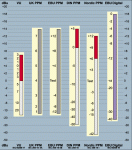How do you do it?
Almost every in the box mix I hear in this place is louder than mine.
Some when I download into my daw or just as a wav file are bouncing slightly into the red on drum peaks but still sound good.
I'll push my mixes into the top of the yellow on protools being very careful to never let it go red on the master. I'll run a bit of limiting on the master buss to keep it in line.
But then I'll run another mix from someone else and it's louder to the point where I have to bring the volume down.
I just dont understand. Because it seems like I'm raising the volume in the daw master buss as high as I can, but it's not enough.
In analog mixes I don't have that issue. I can get those plenty loud.
Im not trying for a squashed all to hell loudness war kind of thing, just comparable volume levels to other stuff.
Almost every in the box mix I hear in this place is louder than mine.
Some when I download into my daw or just as a wav file are bouncing slightly into the red on drum peaks but still sound good.
I'll push my mixes into the top of the yellow on protools being very careful to never let it go red on the master. I'll run a bit of limiting on the master buss to keep it in line.
But then I'll run another mix from someone else and it's louder to the point where I have to bring the volume down.
I just dont understand. Because it seems like I'm raising the volume in the daw master buss as high as I can, but it's not enough.
In analog mixes I don't have that issue. I can get those plenty loud.
Im not trying for a squashed all to hell loudness war kind of thing, just comparable volume levels to other stuff.





 )
)